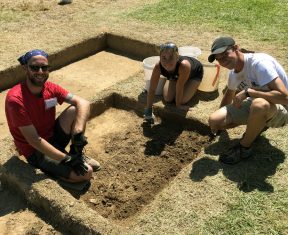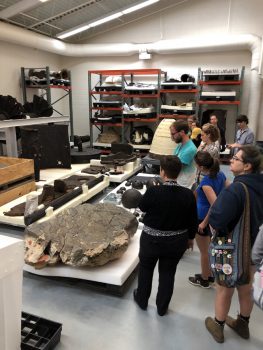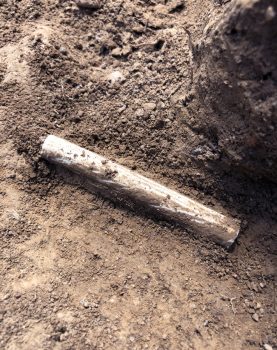Back to Dispatches from Field School
Field School 2019 – Week 3
Julia Weber — St. Mary’s College of Maryland
“A Field Trip and Finding Features”
The third week of the 2019 Field School began with a very gloomy weather forecast, but we all met on site promptly Monday morning to get in as much digging as we could. Lab rotations also began this week, so three students were sent to the lab to begin washing artifacts found out in the field, while also learning lab procedures and techniques. We had to bail out water from units due to heavy rain over the weekend, and for the most part the units were in good shape. Also, after days of digging and screening plow zone, most units finally reached the subsoil! This was an exciting time because we began to see possible features. Unfortunately, however, due to the weather looking bad, we decided to pack up the site early to avoid any rain falling on us (or the excavation units) out on site.
On Tuesday we took our first field trip to the Jefferson Patterson Park Museum and Maryland Archaeological Conservation Lab, where we were given a tour of their top notch facilities and some really cool artifacts, like a WWII vessel that was in the beginning stages of curation, and several large pieces of wood from a shipwreck during the War of 1812. After we reconvened from our lunch break overlooking the beautiful scenery from the park, we were given a tour of two archaeological sites on the property and were able to see how their process works. We stopped by the Visitor Center on our way out to read their FAQ exhibit about how archaeology works, and how the museum came to be. [Editor’s note: our heartfelt thanks to MAC Lab Executive Director Dr. Patricia Samford for giving us a wonderful tour of the lab facilities and the excavation sites!]

Field school students Chris Rico (left) and Abigail Kuehne (center) working with Field Assistant Kyle Vanhoy (right)
Wednesday began by again bailing out water from the plastic covered units, all of which were in good shape. All the students out in the field made tremendous progress on their units, and we were finally able to take down the baulk, which was separately two adjacent units from each other. Once the baulks were removed and the sidewalls were trimmed down, my partner and I were moved to another unit to help. We were able to trowel down a good portion of their corners, in order to make the floor more even, and shave down the sidewalls as well. We closed the site a bit early to make it back to the Study Collection room for our first study session for our midterm! During this session, students could take their time handling ceramics and glass spanning three centuries; from what I heard most students know their artifacts rather well, hopefully that will prove true on our exam next week!
On Thursday we finally got a good days’ worth of field work in, while also dodging some misty rain over us for a few minutes. We also broke ground on a new unit, and mapped out the adjacent unit as well, hopeful that we can open it on Friday. As we were inching closer to closing time, Travis was eager to find a feature in two units where the baulk was removed. As he scraped away at the soil, sprayed the floor with water, and moved a tent to cover the unit, he was able to see something! Travis broke out the camera to take pictures of the feature, and although we are not yet sure what it is, I am excited to find out!
Friday was a beautiful day full of clear skies and high winds, and luckily the temperature did not even reach eighty degrees! It was a truly exciting day for the Field School, especially because the feature previously mentioned above turned out to be a fence line, and we found lots of interesting artifacts. I am excited to get back to work on Monday and see what other amazing things are just beneath our feet!



